You may think you’re exercising your deltoids regularly, but your shoulders aren’t getting bigger or wider.
Then you are thinking, right:
Include side delt exercises in your workout routine. This will help make your shoulders look bigger and rounder.
Your deltoids are probably your most noticeable body part. Well-developed shoulders widen your upper body and make you look powerful and strong.
In this post, you will find a step-by-step breakdown of the 20 best side deltoid exercises that you can add to your shoulder workout regime.
Subsequently, we’ve covered the following:
- Shoulder Muscles Anatomy
- Benefits Of Strong, Well-Built Lateral Deltoid
- Training Tips For Side Delt Exercises

- 20 Best Lateral Deltoid Exercises
- Barbell Side Delt Exercises
- 1. Barbell Overhead Press
- 2. Behind-the-Neck Press
- 3. Barbell Upright Row
- Dumbbell Lateral Delt Exercises
- 4. Arnold Shoulder Press
- 5. Dumbbell Lateral Raise
- 6. One-Arm Dumbbell Upright Row
- 7. Upright Row
- 8. Incline Bench Rear Lateral Raise
- 9. Lying Dumbbell Lateral Raise
- 10. Dumbbell One-Arm lateral raise
- 11. Dumbbell Armpit Row
- Cable Lateral Or Side Delt Exercises
- 12. Cable Upright Row
- 13. One Arm Cable Lateral Raise
- 14. Cable Machine Y Raise
- Bodyweight Side Delt Exercises
- 15. Forearm Side Plank
- 16. Elevated side plank
- 17. Side Plank Lateral Raise
- 18. Pike Push Up
- 19. Handstand Push Up
- 20. Resistance Band Lateral Raise
- Know About Your Shoulder Muscles (Anatomy)
- Anterior Deltoid
- Posterior Deltoid
- Lateral Deltoid
- Benefits Of Strong, Well-Built Lateral Deltoid
- 1. Reduced Risk of Injury
- 2. Improve Range of Motion
- 3. Improve Lifts
- 4. Give aesthetics Look
- Add Side Delt Exercises Into Your Workout Routine
- 1. As a Standalone Exercise
- 2. As Part of a Shoulder Workout
- 3. As Part of a Full-Body Workout
- Training Tips
- FAQs
- How do you train side delts for size?
- Can you train side delts every day?
- How can I work my side delts at home?
- Do side delts make you look bigger?
- Conclusion
- References
- 12 Best Lateral Delt (Side Delt) Exercises and Workouts
20 Best Lateral Deltoid Exercises
We compiled 20 of the best lateral deltoid exercises that should be incorporated into your normal shoulder workout schedule.
Many of the side delt exercises below can be done with various equipment, including barbells, dumbbells, cable machines, body weights, and resistance bands.
So, we have created the side delt exercises for many sections, such as:
- Barbell Lateral deltoid exercises
- Side delt exercises with Dumbbells.
- Cable Lateral deltoid exercises
- Bodyweight lateral delt exercises at Home (No Equipment).
- Side Delt workout with the Resistance band.
Barbell Side Delt Exercises
Barbells are a valuable tool in the arsenal of a person who wants to gain strength efficiently. Exercise experts also point to several other benefits of barbells exercises.
- Side delt barbell exercises provide versatility and can help you strengthen virtually every muscle in the body with a wider range of resistance.
- The barbell is a basic tool, so learning the basic lifts quickly is easy.
1. Barbell Overhead Press
The Overhead press is the best shoulder muscle mass builder exercise. The shoulder Press remains the granddaddy of all shoulder exercises to build big, round shoulder muscles.
Seated shoulder press has been the favorite shoulder exercise with bodybuilders as it builds muscle fast and is a power move.
Performing the exercise while seated upright is a stricter version than standing and prevents cheating the weight upward using momentum generated by the legs.

How To Do
- Sit on an exercise bench and grab a bar with an overhand grip.
- Bring the bar over and in front of your head, under your chin, and just above your upper chest.
- Now Press the bar straight up overhead until your arms are fully extended but not locked out.
- Slowly lower the bar back to the starting position.
Tips
- Perform a warm-up with 50% weight for 1–2 sets.
- Always perform the Shoulder Exercises before you perform the triceps.
2. Behind-the-Neck Press
The standard military press and the overhead dumbbell presses hit more of the anterior head of the deltoid, which is often stimulated a lot, even during the bench press.
Behind the neck press, on the other hand, stimulates all the three heads of the shoulder, It also recruits the triceps, lateral delts, traps, and rhomboids.
If you do not have a fair amount of shoulder mobility, this exercise is not recommended.
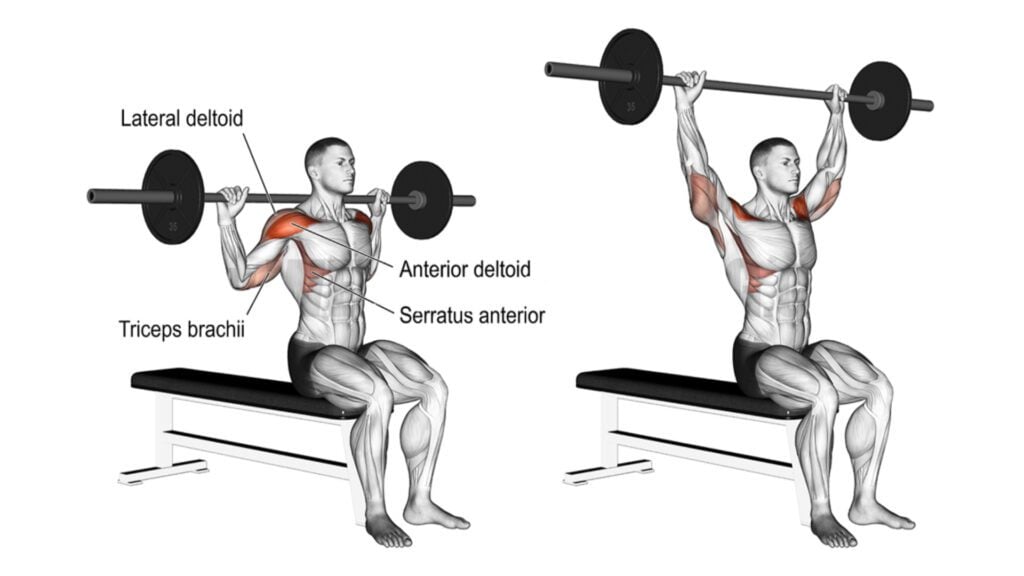
How To Do
- Sit on an exercise bench and place the barbell just below shoulder height.
- Elevate the barbell overhead by fully extending your arms while breathing out.
- Hold the contraction for a second and lower the barbell back down to the starting position by inhaling.
- Repeat for the desired number of repetitions.
Tips
- Don’t bounce the bar off your neck. Perform the exercise in a slow and controlled manner.
- Perform a warm-up with 50% weight for 1–2 sets.
- Keep your elbows flared out, aligning with the shoulders or slightly behind.
3. Barbell Upright Row
The upright row is one of the excellent side delt exercises to build huge trapezius muscles and lateral delt.
Barbell upright rows can be done with both narrow grips and wider ones.
- The narrow grip focuses on the trapezius,
- And the wider focus on the entire shoulder girdle.
- Moreover, the wider grip allows some cheating movement, thereby allowing you to lift more weight.

How To Do
- Hold a bar with a narrow overhand grip and let it hang before you.
- Lift the bar and get it as close as possible to the chin, using your arms and elevating your shoulders to squeeze your trapezius muscles.
- Now, lower the bar under controlled motion until it returns to its starting position.
- Repeat for desired reps.
Tips
- Focus on keeping your elbows higher than your forearms.
- Keep a controlled motion and avoid jerky movements.
Dumbbell Lateral Delt Exercises
There are many advantages of doing side delt exercises using dumbbells, such as:
- Dumbbells require more balance than barbells or machines, which can lead to greater muscle fiber recruitment.
- Lateral delt exercises with dumbbells allow unilateral training, increase core stability, and improve muscular imbalances.
- Dumbbell affords a greater variety, preventing physical and mental burnout.
- Dumbbell exercise variations allow for a greater range of movement (ROM).
4. Arnold Shoulder Press
The Arnold dumbbell press is an excellent exercise for strengthening the shoulders. Arnold’s press stands out from the crowd as the best exercise with the best range of motion for shoulder muscles.
It gives a wide range of motion as you lower the dumbbells well down in front, giving that maximum stretch other shoulder exercises lack.
You should add this side deltoid exercise to your exercise regimen.

How To Do
- Stand straight, holding a dumbbell in each hand. Raise the dumbbells to the shoulder position with palms facing you.
- Now press the dumbbells overhead just like dumbbell presses, but twist them so that palms face forward at the movement’s top.
- Now lower the dumbbells in a reverse movement.
Tips
- Inhale when you lower the weight and exhale when you lift.
- Keep a controlled motion and avoid jerky movements. Keep a strict form.
- Do not lock your arms overhead.
5. Dumbbell Lateral Raise
The dumbbell lateral raise is a fantastic shoulder exercise that targets those side deltoid muscles, giving you those shapely and strong shoulders you’ve always wanted.
Unlike other exercises that work multiple muscle groups, this one goes straight to the side delts.
That means you can really focus on building them up and getting that nice shoulder shape. It’s a must-do exercise for your lateral deltoid workout.

How To Do
- Hold a dumbbell in each hand and bring the weights together in front of you.
- The palms should be facing each other.
- Now bend your elbows and raise the dumbbells to your sides.
- Lift them to a point slightly higher than your shoulders.
- Now lower the dumbbells in a controlled manner back to the starting position.
Tips
- Don’t just swing your arms. Keep controlled motion throughout the exercise.
- Perform a warm-up with 50% weight for 1–2 sets.
- Always use weights that you can handle comfortably.
6. One-Arm Dumbbell Upright Row
The one-arm dumbbell upright row is a popular way to isolate the side delts. It also helps to establish a strong mind-muscle connection.
Because it works on each shoulder separately, it can fix any differences in strength between your left and right sides.

How To Do
- When you are standing, your feet should be shoulder-width apart.
- Hold a dumbbell with your right hand by your side.
- The dumbbell should be pulled towards your ear.
- At the top, take a moment to pause and then contract the muscles.
- Slowly lower the weight back to the initial position.
- After doing all the exercises on the left side, do them again on the right side.
- Repeat 10–12 reps on each side.
Tips
- Keep a controlled motion and avoid jerky movements.
- Keep your back straight and core tight.
- To add a bit of intensity to the exercise, you should lower the dumbbells slowly.
7. Upright Row
The dumbbell upright row is a fantastic compound exercise that targets the muscles in your side delt, upper back, and traps.
Research shows that the upright row is one of the best exercises for building shoulder strength and stability.
It can be done with different grip widths.
- A close or narrow grip (half of shoulder width),
- A standard grip (shoulder width grip)
- A wide grip (wider than the shoulder)

How To Do
- Hold a dumbbell in each hand, palms facing your body, with your feet shoulder-width apart.
- Allow your arms to hang straight down while maintaining a slight bend in your elbows.
- Keep your chest up, shoulders back, and your core engaged.
- The dumbbells should be lifted vertically towards your chin.
- Keep the weights close to your body while doing the exercise.
- Pause for a moment when the dumbbells reach the height of your chest.
- Lower the dumbbells back to the starting position.
Tips
- Remember to exhale while you exert.
- Keep a controlled motion and avoid jerky movements.
8. Incline Bench Rear Lateral Raise
The incline bench rear lateral raise is an upper-body exercise that targets the upper back’s rear delt, lateral delt, and postural muscles.
The incline bench takes away the potential of using momentum, making the movement more challenging and developing bigger, more balanced, and healthier shoulders.

How To Do
- Sit in the reverse direction on an incline bench (45 degrees) while holding dumbbells with neutral grips.
- Hold the dumbbells so that they hang straight down from your shoulders.
- Slowly lift the dumbbells up and out to the sides of your body, pulling through the rear delts and middle traps.
- Pause a moment at the top of the motion before slowly lowering the weights back down to the starting position.
Tips
- Do not lift backward or forward.
- Set a bench at about 30–45 degrees inclined.
- Keeping your wrists straight during the exercise and your elbows above your wrists is important.
9. Lying Dumbbell Lateral Raise
If you’re looking for a way to get more creative with your lateral delt workout, why not try a lying dumbbell lateral raise?
The side-lying lateral raise increases strength and stability throughout the entire shoulder. This exercise more specifically targets the side deltoid.
Having a great lateral head will give the illusion of a super-wide set of shoulders.
Incline side laterals are perhaps difficult for beginners, but they are an interesting variation on conventional lateral raises.
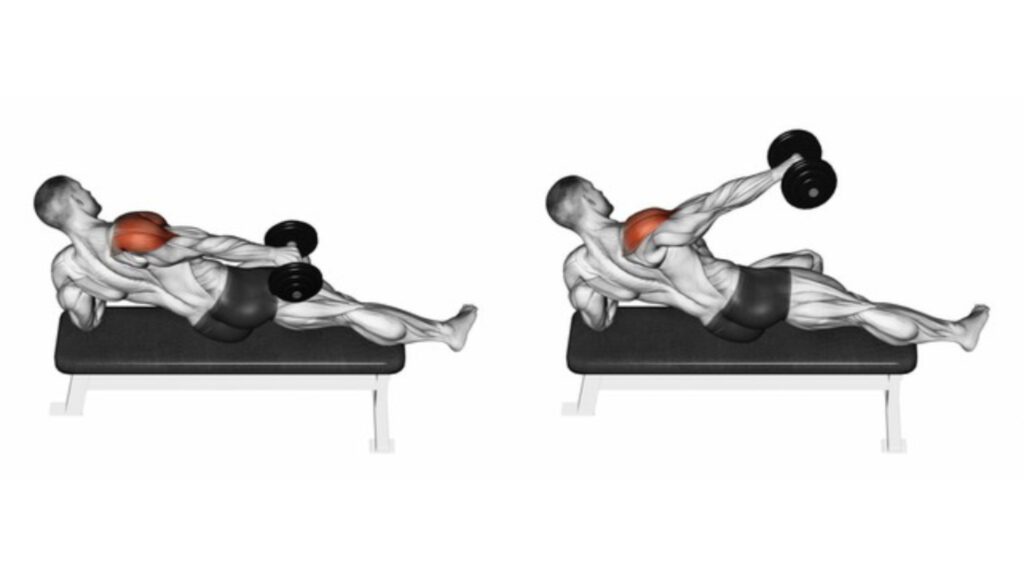
How To Do
- Lie sideways on a flat bench, propping yourself up onto your elbow, so it is perpendicular to the bench.
- Hold the dumbbells so that they rest sideways on your upper thigh
- Slowly lift the dumbbells up and out to the sides of your body, pulling through the rear delts and middle traps.
- Pause a moment at the top of the motion before slowly lowering the weights back down to the starting position.
- The “top” of the movement is when the shoulder joint is at a 90-degree angle to the body.
Tips
- Do not lift backward or forward.
- Avoid using momentum. Focus on moving in a slow and controlled fashion the entire time.
- Your working elbow should be slightly bent during the lift.
10. Dumbbell One-Arm lateral raise
One-arm lateral raise is performed with one arm at a time, and it is an excellent exercise to isolate and build side deltoids.
To build the middle head of the deltoid muscle, make dumbbell one-arm lateral raise a part of your side delt exercises.

How To Do
- Stand holding a dumbbell with one hand. Feet are shoulder-width apart and knees are slightly bent.
- Now bend your elbow and raise the dumbbell to your side.
- Lift them to a point slightly higher than your shoulder.
- Now lower the dumbbell in a controlled manner back to the starting position.
- Perform all reps on one side and then repeat with the other arm.
Tips
- Pause momentarily at the top before slowly lowering the dumbbell back to the starting position.
- Keep a controlled motion and avoid jerky movements.
- Avoid arching of the lower back.
11. Dumbbell Armpit Row
If you’re looking for a way to get more creative with your side delt exercises, why not try this?
Dumbbell Armpit Row, or monkey Row, offers a great alternative for trap and side deltoid development like the upright row.
It can help solve a litany of shoulder and neck pain. I would recommend incorporating the exercise as part of your warm-up routine or near the end of your workout to work the traps.
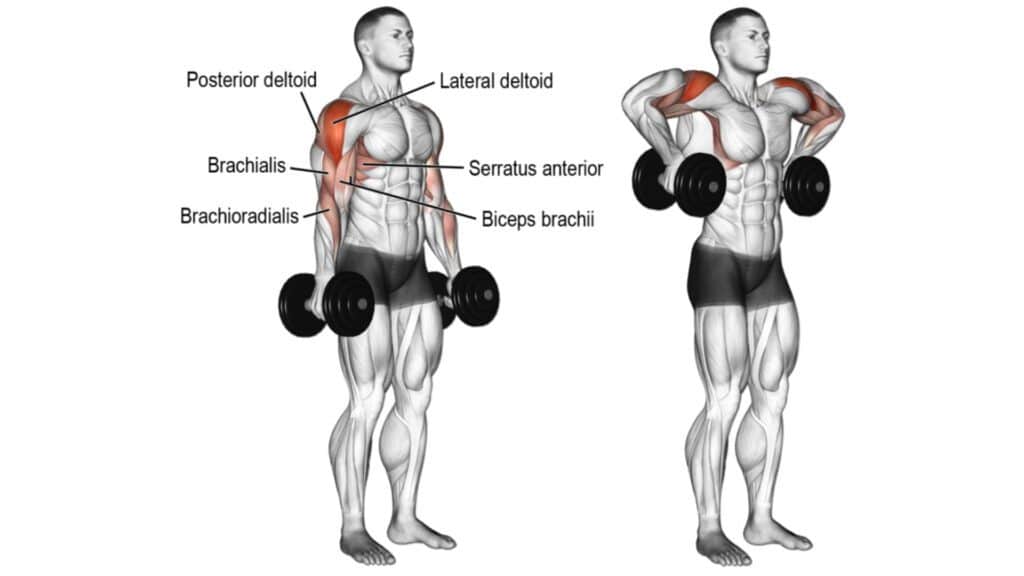
How To Do
- Stand holding a pair of dumbbells by your sides, with your palms facing your thighs.
- Exhale as you pull the dumbbells up the sides of your torso towards your armpits, with your elbows pointing out to the sides.
- Hold for a count of two. Inhale as you lower the dumbbells to the starting position.
Tips
- Pull with your elbows, not your biceps
- Keep a controlled motion and avoid jerky movements.
Cable Lateral Or Side Delt Exercises
The cable side delt exercises offer an effective way to train the rhomboid muscle. Let’s take a look at some other benefits of lateral delt exercises with a cable machine.
- For people who experience discomfort in their joints during the barbell press, cable shoulder workout are a great alternative. The cable changes the angle of the movement enough to limit the potential stress on the joints.
- Cable exercises are more evenly distributed, and you have more of a constant load on your side delt muscles throughout the whole range of motion.
- The cable lateral delt exercises offer almost unmatched versatility because you can easily change the load, angle, grip positioning, and body positioning.
- The cable setup gives your muscles almost uninterrupted time under tension and a huge pump — each of which can help optimize muscle growth.
12. Cable Upright Row
The Cable upright row is a movement that targets many of the large muscles in the upper back and shoulders, which is key for many movements in strength, power, and fitness sports.
Cable machines keep tension on the muscles throughout the entire range of motion, ultimately increasing muscle activation and hypertrophy.
Upright rows are an exercise that nearly everyone can do using a wide variety of grip widths.

How To Do
- Attach a straight bar to a low cable pulley. Grab the bar using a shoulder-width or wider overhand grip.
- Stand close to the pulley with your body upright, your shoulders pulled back.
- Exhale as you pull the bar up the front of your body until it reaches your lower or middle chest level.
- Do not pull the bar up any higher. Hold for a count of two.
- Inhale as you lower the bar to the starting position.
Tips
- Bend slightly at the knees and stand with feet shoulder-width apart.
- Keep your shoulders back, chest out, and body upright.
13. One Arm Cable Lateral Raise
The one-arm cable lateral raise is an isolated shoulder exercise that targets the side deltoids. It also increases stability in both the wrists and the core.
You can use both arms while performing the exercise, but it is often recommended to use just one to add more difficulty to your workout and stimulate more gains.
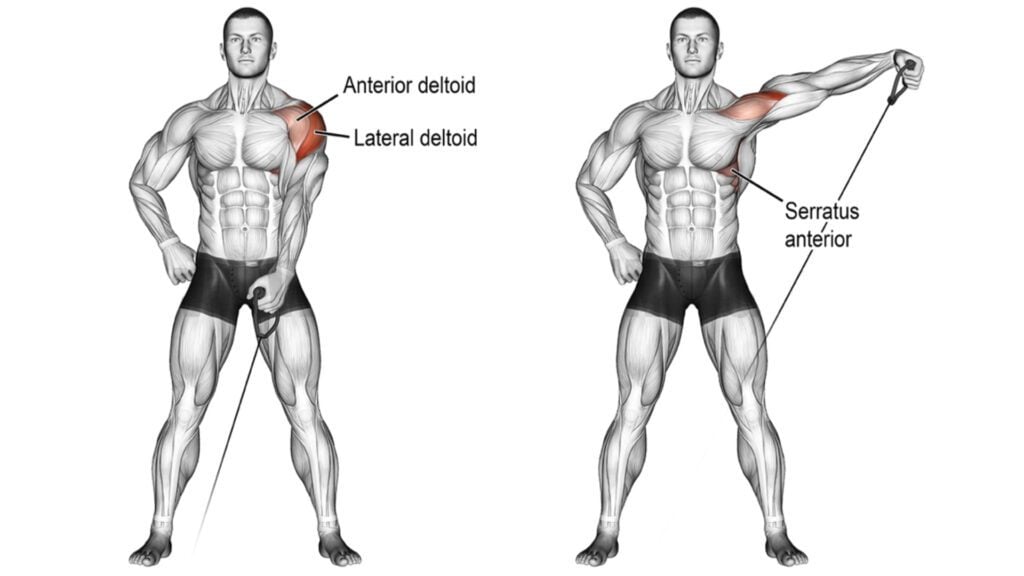
How To Do
- You should stand next to a cable pulley machine with your feet shoulder-width apart and the handle attachment set to the lowest setting.
- To stand up straight, move your chest forward and pull your shoulder back.
- Keep your elbow slightly bent and raise your arm to shoulder height.
- Hold for a second, and then slowly lower the weight back to the starting position.
Tips
- Ensure your torso is still, your back is straight, and your elbow is slightly bent.
- Keep controlled motion.
- Always use weights that you can handle comfortably.
14. Cable Machine Y Raise
This is one of the best two-arm cable side delt exercises that you can do during your shoulder workout.
The cable Y-raise is a fantastic exercise for the whole shoulder that activates all fibers of the deltoid anterior, lateral, and posterior, but it mainly targets the side delt.
This lateral deltoid exercise combines horizontal shoulder abduction with external shoulder rotation. It is strengthening the external shoulder rotators and the internal shoulder rotators.
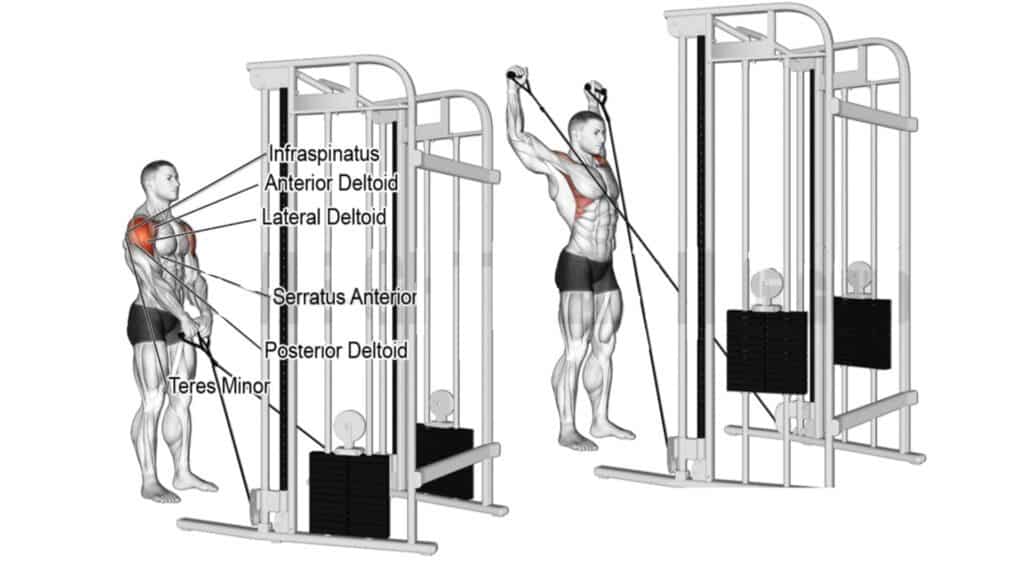
How To Do
- Stand facing between two low cable pulleys, with each hand holding the handle of the cable of the opposite pulley.
- Push your chest forward and point your shoulders back to keep your posture straight.
- Maintaining a slight bend in the elbows, raise your arms upwards and outwards, forming the letter ‘Y’ with your whole body.
- Hold for a second, and then slowly lower the weight back to the starting position.
Tips
- Maintain a fixed, slightly bent elbow position.
- Keep your torso still, your back straight, and your elbow slightly bent.
- Don’t just swing your arms. Keep controlled motion throughout the exercise.
Bodyweight Side Delt Exercises
You can simply and effectively train your side delt muscle by using these bodyweight exercises at home, and you do not need any pieces of equipment for this as well.
There are many other benefits of training at home, such as:
- No gym members are required,
- Provide more flexibility as you can train as per your schedule,
- Required limited space.
15. Forearm Side Plank
The forearm side plank is one of the best abs and side delt exercises for strengthening the oblique abdominal muscles and deltoid.
If you’re new to planking, you should master the basic forearm plank before moving on to the side plank variation.
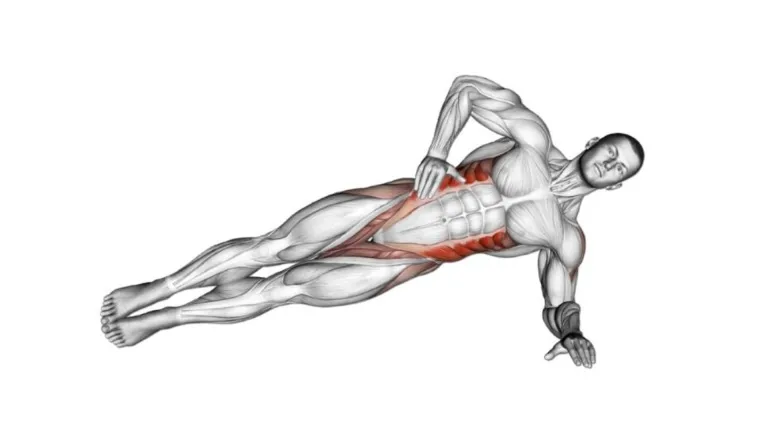
How To Do
- Place your right foot on the floor, with your left foot resting on top of the inner side of your right foot.
- Raise your body by placing your right forearm flat on the floor to be perpendicular to your torso.
- Lift your torso until your right upper arm is straight underneath you, with your elbow bent 90 degrees and your forearm flat on the floor.
- In this position, only your right forearm and the outer side of your right foot contact the floor, and your body forms a diagonal line that is at about a 20-degree angle to the floor.
- Keep your abs pulled in tight and hold this position for as long as you can, and then repeat on the left side.
Tips
- Keep your legs and body straight.
- Avoid letting your hips sag during these oblique exercises.
- Squeeze your abs and glutes throughout the movement for stability.
16. Elevated side plank
The side plank with feet on the bench is a progression from a normal side plank that targets the core, with an emphasis on the obliques.
Performing with feet elevated also increases the resistance on the shoulders and triceps.
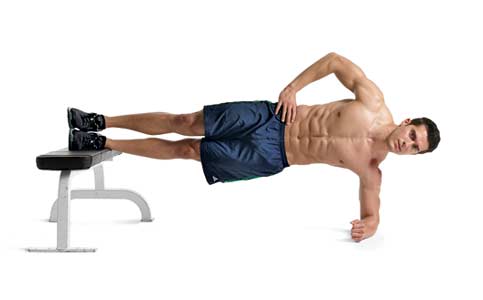
How To Do
- Get in a side plank position with a forearm on the floor and feet on an elevated surface (a bench, box, step, or chair).
- Contract your abs, pulling the belly button in toward the spine.
- Slowly raise the weight, making sure not to extend beyond your shoulder.
- Hold for 1–3 seconds when at the top of the rep.
- Slowly lower back to the starting position. Repeat on your other side.
Tips
- Don’t let your shoulders roll forward. Keep your chest up and shoulders back.
- Squeeze your glutes and your abs to keep your body stable.
17. Side Plank Lateral Raise
The side plank lateral raise is an exercise that combines an isometric side plank hold with a dumbbell raise to target both the core and the side of the shoulder.
You probably won’t be able to use much weight without disrupting your balance. Even at light weight, this is a move that’s capable of tackling multiple muscle groups in a quick workout.
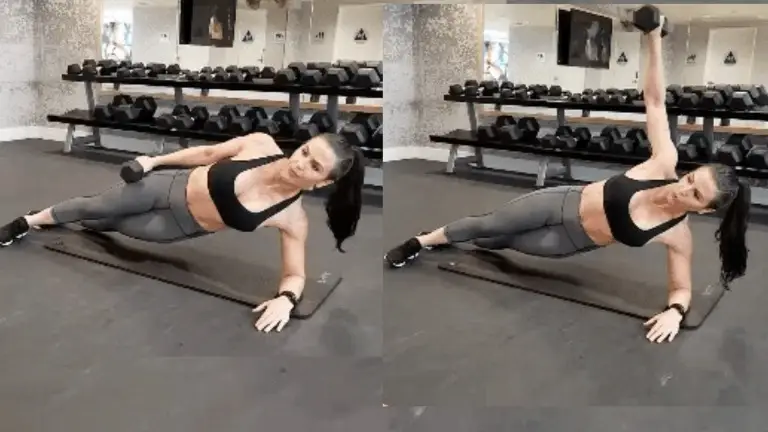
How To Do
- Get in a side plank position by lying on your right side on the floor with your left foot resting on top of your right foot.
- Hold a dumbbell in your top hand, with your arm resting along the side of your body.
- Slowly raise the weight, making sure not to extend beyond your shoulder.
- Hold for 1-3 seconds when at the top of the rep.
- Slowly lower your arm back down.
- Complete desired no. of repetition. Repeat on your right side.
Tips
- Avoid letting your hips sag during these oblique exercises.
- Squeeze your abs and glutes throughout the movement for stability.
18. Pike Push Up
Pike push-ups are among the best bodyweight lateral deltoid exercises that increase shoulder strength and stability.
It is a difficult version of the traditional push-up that emphasizes your shoulder muscles and also trains your triceps and chest.

How To Do
- Start in a standard push-up position with your hands slightly wider than shoulder-width apart and elbows completely locked out.
- Lift the hips up and back until your body forms an inverted V shape.
- Keep arms and legs as straight as possible.
- Slowly lower the top of your head towards the ground. Once your head is about to contact the ground, pause for a second.
- Then, slowly push back until your arms are straight and you’re in the inverted V position.
Tips
- Make sure you maintain control throughout the movement.
19. Handstand Push Up
Finally, if you’re looking for one more effective bodyweight lateral delt exercise, try the handstand push-up, aka vertical push-up.
To prepare the strength until one has built adequate balance, the feet are often placed against a wall, held by a partner, or secured in some other way from falling.
Handstand push-ups require significant strength, balance, and control if performed freestanding.
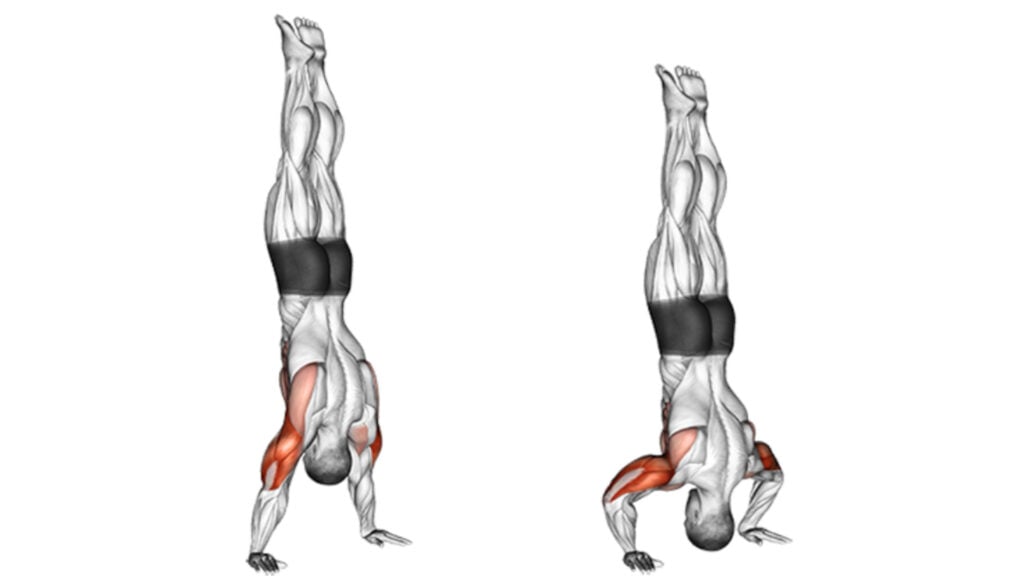
How To Do
- Place hands about 6–12 inches away from the wall and slightly wider than shoulder-width apart.
- Make sure palms are facing forward or slightly turned out 5–10 degrees.
- Kick up into a handstand with your heels touching the wall.
- Once you have kicked up, establish a strong, rigid midline position.
- While maintaining this position, lower yourself until the top of your head touches the floor.
- Try to keep your elbows at a 45-degree angle as you lower.
- Once your head touches the floor, press up with the same tightness you had, lowering yourself until your elbows reach full extension.
Tips
- Not to arch your back and keep contracting your abs.
- Do not do this move on consecutive days. Rest for at least two days before trying this move again to give your body time to recover.
- Point your toes, squeeze your glutes, and grip the ground with your fingertips for better stability.
20. Resistance Band Lateral Raise
Resistance band lateral raise is the best exercise to build side deltoids that you can do at home.
It is a variation of the dumbbell lateral raise and an exercise used to strengthen the muscles of the shoulders.
It uses bands to help make the shoulder exercise harder. As you get closer to the full contraction, more resistance is applied to the target muscle groups.
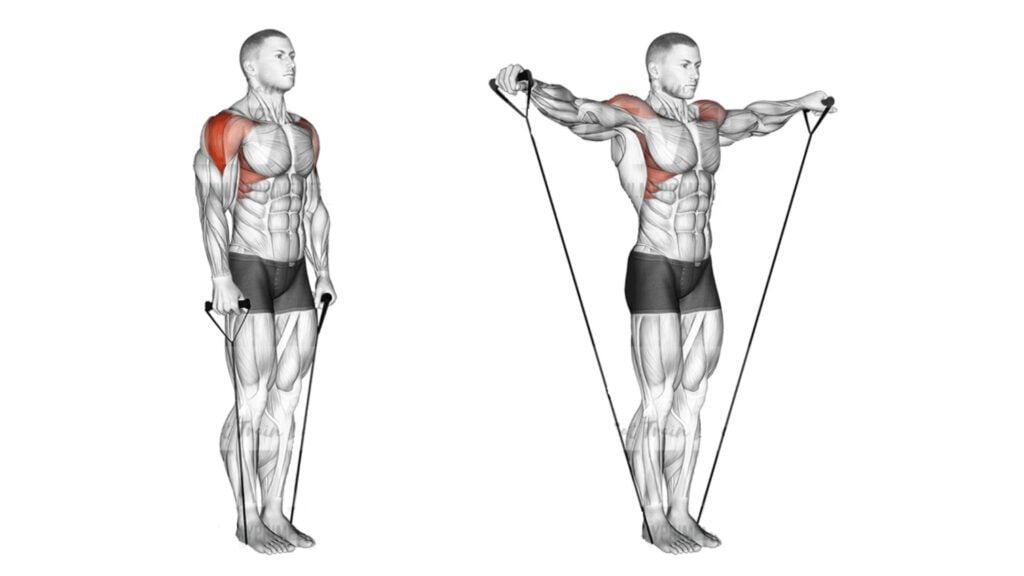
How To Do
- Stand on your resistance band with your feet at shoulder width and a handle in each hand.
- Tighten your abdominals and avoid arching your back.
- Keep your elbows slightly bent at all times.
- Slowly raise your arms up from the sides of your body
- Once your arms reach parallel with the floor, pause, then slowly lower your arms back down to the starting position.
Tips
- Raise your arms straight up and in line with your body. Do not jerk up. Raise slowly in a smooth, controlled manner.
- Inhale as you lower your arms and exhale as you raise them.
- Spread feet wider on the band to increase resistance.
Know About Your Shoulder Muscles (Anatomy)
In fitness, “shoulder exercises” refer to resistance exercises that target the deltoid muscle.
The deltoid is the superficial muscle that forms the rounded contour of your shoulder. While the deltoid is technically a single muscle, anatomically speaking, it has three distinct sets of muscle fibers and muscle bellies, which are referred to as “heads.
The deltoid muscle of the shoulder consists of three separate sections or heads.
- Anterior deltoid (In front),
- Lateral deltoid (Side Delt), and
- Posterior deltoid (behind),

Anterior Deltoid
The Anterior Deltoid is commonly called the front delt. It arises from your collar bone and inserts into your humerus (upper arm bone).
The Front delt’s main function is to move your arm up, forward, and to your center.
Posterior Deltoid
The Posterior Deltoid is also known as the rear delt. It arises from the spine of your scapula (upper part of your shoulder blade) and inserts into your humerus.
Its main function is moving the arm outward and backward.
Lateral Deltoid
The Lateral Deltoid has a few common names, such as side delts and middle delts. It arises from a little area on your shoulder blade called the acromion process and inserts into your humerus.
Its main function is shoulder abduction, which is bringing it up to the side.
The side delt is important in how your shoulders look and feel. Focusing on this area can make a difference in your upper arm, so you want to give it the best exercises to promote the lateral deltoid’s growth and development.
You need to start giving this muscle more attention if you want to develop proper 3D shoulders.
Benefits Of Strong, Well-Built Lateral Deltoid
Big, strong, rounded shoulders have numerous benefits besides just looking good.
The deltoid is among the most important muscles in the body as we use it in everyday life activities to push, pull, and lift objects over our heads.
For this post, we narrow it down to the benefits of having strong side delts.
The benefit of having strong, well-built lateral delts is simple.
1. Reduced Risk of Injury
Many people experience shoulder pain or injuries at some point in their lives because the shoulders move through a large range of motion. Strengthening the side delts helps to stabilize the shoulders, which can help prevent future injuries.
2. Improve Range of Motion
They help protect your shoulder joint, keeping it stable during arm movements. Strong front delts will make arm movements that involve shoulder flexion, internal rotation, and abduction more powerful and productive.
3. Improve Lifts
The lateral deltoids play a part in stabilizing the weight when performing bench press or overhead press. By working directly on the side delt, there will be a transfer of strength to your other lifts.
4. Give aesthetics Look
One hallmark of someone who’s in shape is having wide-toned shoulders. It improves the overall aesthetics and definition of your shoulders.
The lateral delts are on the outside of the shoulder, so if you work on building them up, you can change the look of your overall body.
Add Side Delt Exercises Into Your Workout Routine
The lateral delt exercises can be incorporated into your workout routine in various ways. Here are some options:
- As a standalone exercise: Do on 3–4 sets of 8–12 reps.
- As part of a shoulder workout: Do them along with other shoulder exercises.
- As part of a full-body workout: Do them with other compound exercises like squats, deadlifts, and bench presses.
1. As a Standalone Exercise
Goal: Focus on targeting the rear deltoids.
| Exercise | Sets | Reps | Rest Interval |
|---|---|---|---|
| Lateral Raise | 4 | 8-12 | 60 seconds |
2. As Part of a Shoulder Workout
| Exercise | Sets | Reps | Rest Interval |
|---|---|---|---|
| Shoulder Press | 4 | 6-8 | 90 seconds |
| Dumbbell Lateral Raises | 3 | 10-12 | 60 seconds |
| Rear Delt Flys | 3 | 12-15 | 60 seconds |
| Front Raises | 3 | 10-12 | 60 seconds |
3. As Part of a Full-Body Workout
| Exercise | Sets | Reps | Rest Interval |
|---|---|---|---|
| Deadlifts | 3 | 6-8 | 90 seconds |
| Pull-Ups | 3 | 8-10 | 60 seconds |
| Squats | 4 | 8-10 | 90 seconds |
| Shoulder Press | 3 | 12-15 | 60 seconds |
| Bench Press | 3 | 8-10 | 60 seconds |
Training Tips
To sum it up, you should hit your side delts directly at least 2 times a week, but if you’re lacking in this area, you might want to work them more often than that.
Try to stay under 20 sets a week in total while having a holistic approach to the rep ranges you use.
The side delts will respond best to mid-high rep ranges; don’t let your ego get in your way.
FAQs
How do you train side delts for size?
To train side delts for size, focus on exercises specifically targeting lateral deltoid muscles.
Perform lateral delt exercises like Dumbbell Lateral Raises, Cable Lateral Raises, Arnold presses, and Overhead shoulder presses.
Can you train side delts every day?
No, it is not recommended to train side delts (lateral deltoids) every day. Overtraining the side delts can lead to fatigue, an increased risk of injury, and hinder muscle growth. It’s best to allow at least 48 hours of rest between intense shoulder workouts.
How can I work my side delts at home?
You can work your side delts at home by performing bodyweight delt exercises like side plank, pike push-ups, and handstand push-ups.
To effectively target your side deltoids at home, it is recommended to grab water bottles, canned goods, or any other weighted objects and perform lateral raises.
Do side delts make you look bigger?
Yes, having strong side delts can make your shoulders look bigger and more defined. Strong and sculpted side delts add width to the shoulders, creating a V-tapered shape.
Conclusion
These lateral deltoid exercises are highly recommended for anyone interested in building a wider shoulder and who wants to gain strength.
It allows for targeted muscle development and provides an overall 3D look to the shoulder. It is easy to do and requires no more scientific details and fancy equipment.
You will get good results if you incorporate some exercises we listed above into your shoulder workout regimen.
When you do these lateral deltoid exercises consistently, the results will speak for themselves.
Thanks for reading, enjoy working your lateral deltoid exercises.
References
- Sweeney S. ELECTROMYOGRAPHIC ANALYSIS OF THE DELTOID MUSCLE DURING VARIOUS SHOULDER EXERCISES. May 2014.
- Campos YAC, Vianna JM, Guimarães MP, et al. Different Shoulder Exercises Affect the Activation of Deltoid Portions in Resistance-Trained Individuals. J Hum Kinet. 2020;75:5-14. Published 2020 Oct 31. doi:10.2478/hukin-2020-0033
- De Duca CJ, Forrest WJ. Force analysis of individual muscles acting simultaneously on the shoulder joint during isometric abduction. J Biomech. 1973;6:385–393
12 Best Lateral Delt (Side Delt) Exercises and Workouts

Manish brings over 10 years of hands-on experience in weight lifting and fat loss to fitness coaching. He specializes in gym-based training and has a lot of knowledge about exercise, lifting technique, biomechanics, and more.
Through “Fit Life Regime,” he generously shares the insights he’s gained over a decade in the field. His goal is to equip others with the knowledge to start their own fitness journey.
